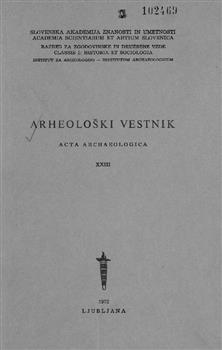Resinous putty and peint on urns
Abstract
In the graves excavated in 1971 in the courtyard of the Slovenian Academy of Sciences (Ljubljana) two urns were found one of which was mended with a resinous material and the other was peinted black. The infrared spectra of both materials are identical and very similar to the spectra published by Sanderman (1) and Sauter (2) of the so called grave resins. W. Sanderman (1) produced infrared spectroscopic and other evidence that the resinous material found in prehistoric graves from the north of Europe is in fact pitch obtained from birch bark. This material seems to be used since neolithic times and up to the very recent past as putty, peint, and for waterproofing of wooden and bark vessels. Sanderman has compared the infrared spectra of the prehistoric material with laboratory made birch bark pitch, but did not consider any other resinuous materials nor pitch from wood tar nor bark pitches from other tree species. Since birch population in this country is not large and, moreover, birch wood was so far not found amongst the remnants of wood used for incinerations, we were wondering whether the pitch from the urns found in Ljubljana originates from birch bark or from any sort of wood. The question appeared interesting because if pitch was indeed made of bark then it was made on purpose and not obtained as a byproduct of burning wood for heating purposes or in making charcoal. Therefore we have prepared pitch from bark of several tree species (birch, beech, poplar, oak, elm) as well as from beech wood, and recorded the infrared spectra. The spectra of a pitch coating formed on an aluminium vessel used for cooking on an open fire was also recorded. In general, the spectra of the bark pitches differ significantly from the wood tar pitch. The differences between the bark pitches are not so well pronounced, but still sufficient to show that the spectrum of birch bark pitch is definitely most similar to the pitch from the urns. Minor differences are possibly due to differences in the conditions of the distillation and, particularly, to ageing. NMR spectra of the pitch from urns, birch bark pitch, and beech wood pitch were also investigated. The spectra of the first two materials are very similar between them, but differ strikingly from the latter. Thus it has been prooved that the pitch from the urns has been made of tree bark, most probably birch bark, and not from wood. The implication of these results are discussed. Some details of the chemical procedures are given and the spectral characteristics are discussed.
Downloads
Downloads
Published
How to Cite
Issue
Section
License

This work is licensed under a Creative Commons Attribution-NonCommercial-ShareAlike 4.0 International License.
Authors guarantee that the work is their own original creation and does not infringe any statutory or common-law copyright or any proprietary right of any third party. In case of claims by third parties, authors commit their self to defend the interests of the publisher, and shall cover any potential costs.
More in: Submission chapter





